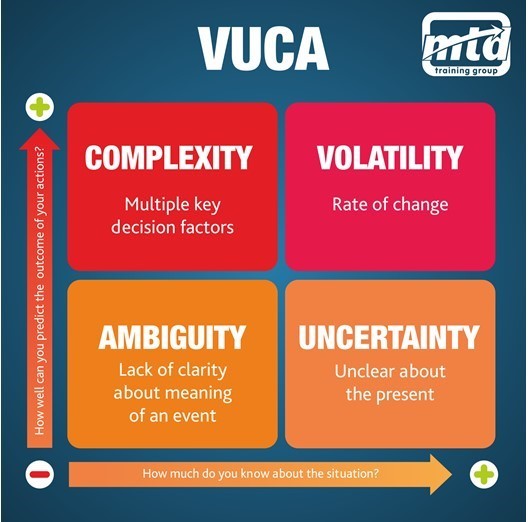Embrace ‘Culture Conversations’
There is a popular acronym – VUCA. Which points to the high pace, complex, challenging environments that organisations operate within. The reality is that the pace, the complexity, the uncertainty and ambiguity are increasing year on year.

Volatility – Volatility refers to the speed of change in an industry, market or the world in general. It is associated with fluctuations in demand, turbulence and short time to markets and it is well-documented in the literature on industry dynamism. The more volatile the world is, the more and faster things change.
Uncertainty – Uncertainty refers to the extent to which we can confidently predict the future. Part of uncertainty is perceived and associated with people’s inability to understand what is going on. Uncertainty, though, is also a more objective characteristic of an environment. Truly uncertain environments are those that don’t allow any prediction, also not on a statistical basis. The more uncertain the world is, the harder it is to predict.
Complexity – Complexity refers to the number of factors that we need to take into account, their variety and the relationships between them. The more factors, the greater their variety and the more they are interconnected, the more complex an environment is. Under high complexity, it is impossible to fully analyse the environment and come to rational conclusions. The more complex the world is, the harder it is to analyse.
Ambiguity – Ambiguity refers to a lack of clarity about how to interpret something. A situation is ambiguous, for example, when information is incomplete, contradicting or too inaccurate to draw clear conclusions. More generally it refers to fuzziness and vagueness in ideas and terminology. The more ambiguous the world is, the harder it is to interpret.
In practice, the four terms are related.
One of the main complaints we hear at Transform Leaders from leaders is that the culture of the organisation/department/team is holding them back from making the changes that they feel are necessary to meet the challenges within their environment.
To succeed in today’s VUCA landscape, organisations need to be comfortable with change, which means that they need to support the individuals on their teams and create the conditions that make behaviour change possible.
Unfortunately, a lot of organisations try to approach behaviour change using tactics that are contrary to what the research shows us about how our brains interpret change requests. Initiatives that trigger a threat response, disrupt well-established routines or expectations without any built in support, or demonstrate a lack of trust in your team, can send individuals into a fight or flight response—and in those moments, their brains are incapable of the high-level functions needed for successful behaviour change.
The prefrontal cortex is “the newest brain, and it enables us to build societies, have good judgment, be strategic, handle difficult conversations, and build and sustain trust. Yet when the amygdala picks up a threat, our conversations are subject to the lockdown, and we get more “stuck” in our point of view.”
Simply put, to manage the complexities of behaviour change effectively, you need team members who are actively using the part of their brain that makes connections—not the animal brain, which is exclusively focused on survival.
Jane Watson wrote about the difficult work of culture change in organisations. As she argues: “Even the most energetic culture change programs cannot succeed if they are solely top-down because trying to control what people believe is nearly impossible. Culture change programs that seek to do this lead employees to feel that the organisation sees them as objects needing to be “fixed.” Resistance naturally follows, as does cynicism about future ‘culture change’ initiatives. Mandating behaviour changes from the top might appear to work for a time, particularly if organisations also align incentives and penalties. But when you push a system, it pushes back, even if it’s not immediately visible.”
Organisations that think about behaviour change as something that sweeps from the top all the way through the organisation will find themselves struggling to get the kind of individual buy-in and action that is required to create and sustain change.
Individuals are complicated, messy, diverse, and difficult to align to centralised objectives. They are also our greatest asset to help achieve the kind of agility in change that is essential for thriving in a VUCA landscape.
By harnessing the wisdom of neuroscience, organisations can begin to create the conditions that individuals need to be comfortable in times of change, and ultimately get the best results.
ACTION POINTS:
- Roll up your sleeves and create change “with” your team instead “for” your team. Recognise that a top-down model may drive quick, but temporary, results. Involve your team in the change process from creation to rollout to drive improvements that stick.
- Create buy-in and engagement through conversations. Pep talks, speeches, and “corporate directives” may boost focus or grab attention, but true two-way conversations build trust, commitment, and ownership in the challenges that you share. Focus on creating dialogue, and spend more time listening than speaking.
Are you interested in ways to build a more conversational model into your culture and routine?
Contact Transform Leaders today to start a simple but effective approach to leveraging conversations that drive positive change in your organisation
